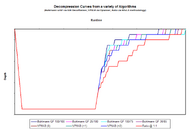I think I should actually title this the lost art of diving without a computer

When I started diving I got a computer and my instructor said to put the tables away and just use the computer, hence I did. I understand the tables but they are for square profiles however the majority of my dives are anything but square.
/QUOTE]
PADI has two approaches: the eRDP ML (an electronic calculator with multi-level capabilities) and The Wheel, a rotating dive table that takes multi-level diving into account.
The problem with either approach is that it is most useful AFTER the dive unless you know EXACTLY what the next dive will look like. I have never known in advance what a dive will look like so neither appeal to me.
So, you have two real choices: use the tables and a square profile or use a computer. The nice thing about tables with multi-level diving is that you almost never push the NDL whereas with a computer, the Remaining Dive Time is, by definition, right at the edge. True, you can finish before the time is up or add a factor to make the computer more conservative but, basically, RDT is a lot closer to the edge than you would ever get with a square profile on a multi-level dive.
For a number of reasons (primarily obsolete gear), I have ordered a computer. I plan to use it in gauge mode for quite a while specifically to force our little group to use tables. After all, the PADI Nitrox course is totally about the tables. How odd that they dropped tables from OW in favor of the eRDP and then turn around and expect competency for the Nitrox course.
Richard
You can actually use square-profile tables (assuming you don't have a multi-level planner like the wheel) to plan multi-level dives; just plan the succeeding levels as repetitive dives with zero SIT.
Richard raises a good point about not knowing what the dive will look like before doing the dive, but if you know the sites and what you're looking for, or if you can get that information, then you can make a reasonable approximation of the dive profile and use that to plan your dive.
While planning the levels, you can also do backup/alternate plans (say +/- 5 or 10 minutes per level, or adjustments on level, i.e., same time but +5 ft.), just to give you an idea of how you can revise your plan as you go and still stay within NDLs.
And then, whether you do the alternate profiles or not, what the computer can do is give you real-time information as you hit the levels, and you can adjust, for example, if you want to spend a little more time at that level, because you've come across something interesting.

When my students start diving with computers, I don't tell them to put away the tables, I encourage them to still plan on tables (and gather all the site information they'll need), and then use the computer as a tool to help maximize the dive.






